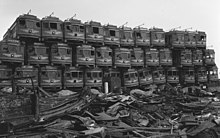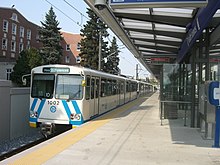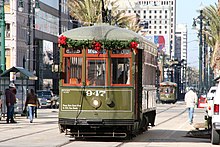Streetcars in North America
Most of the original urban streetcar systems were either dismantled in the mid-20th century or converted to other modes of operation, such as light rail.
About 22 North American cities, starting with Edmonton, Calgary and San Diego, have installed new light rail systems, some of which run along historic streetcar corridors.
From the 1820s to the 1880s urban transit in North America began when horse-drawn omnibus lines started to operate along city streets.
Mules were thought to give more hours per day of useful transit service than horses and were especially popular in the south in cities such as New Orleans, Louisiana.
[2][3] By the mid-1880s, there were 415 street railway companies in the U.S. operating over 6,000 miles (9,700 km) of track and carrying 188 million passengers per year using animal-drawn cars.
The last regular mule-drawn cars in the United States ran in Sulphur Rock, Arkansas, until 1926 and were commemorated by a U.S. Postage Stamp issued in 1983.
[5] The last mule tram service in Mexico City ended in 1932, and a mule-powered line in Celaya, survived until May 1954.
[6] In the 21st century, horsecars are still used to take visitors along the 9-kilometre (5.6 mi) tour of the 3 cenotes from Chunkanán near Cuzamá Municipality in the state of Yucatán.
Similarly, Disney World theme park in Orlando has operated a short horsecar line since it opened in Oct 1971.
Sprague's use of a trolley pole for D.C. current pick up from a single line (with ground return via the street rails) set the pattern that was to be adopted in many other cities.
The North American English use of the term "trolley" instead of "tram" for a street railway vehicle derives from the work that Sprague did in Richmond and quickly spread elsewhere.
The rapid growth of streetcar systems led to the widespread ability of people to live outside of a city and commute into it for work on a daily basis.
The largest of these was the Pacific Electric system in Los Angeles, which had over 1,000 miles (1,600 km) of track and 2,700 scheduled services each day.
[19] In the days before widespread radio listening was popular and in towns or neighborhoods too small to support a viable amusement park streetcar lines might help to fund an appearance of a touring musical act at the local bandstand to boost weekend afternoon ridership.
Sometimes lasting only a few days, more often these strikes were "marked by almost continuous and often spectacular violent conflict,"[20] at times amounting to prolonged riots and civil insurrection.
Samuel Gompers of the American Federation of Labor called the St. Louis Streetcar Strike of 1900 "the fiercest struggle ever waged by the organized toilers"[21] up to that point, with a total casualty count of 14 dead and about 200 wounded.
The survival of the lines that made it past the 1960s was aided by the introduction of the successful PCC streetcar (Presidents' Conference Committee car) in the 1940s and 1950s in all these cities except New Orleans.
City buses were seen as more economical and flexible: a bus could carry a number of people similar to that in a streetcar without tracks and associated infrastructure.
Many transit operators removed some streetcar tracks but kept the electric infrastructure so as to run electrified trackless trolley buses.
While it is true that General Motors, Firestone Tire, Standard Oil of California, Phillips Petroleum, and some other companies funded holding companies that purchased about 30 more of the hundreds of transit systems across North America, their real goal was to sell their products — buses, tires, and fuel — to those transit systems as they converted from streetcars to buses.
The development of light rail systems in North America then proliferated widely after 1985, mostly in the United States, but also in Canada and Mexico.
In 2015, the Mineta Transportation Institute released a peer-reviewed research report[32] which used key informant interviews to examine the experiences on modern-era streetcars operating in Little Rock, Memphis, Portland, Seattle, and Tampa.
The research revealed that in these cities, the primary purpose of the streetcar was to serve as a development tool (in all cities examined), a second objective was to serve as a tourism-promoting amenity (in Little Rock and Tampa), and transportation objectives were largely afterthoughts with the notable exception of Portland, and to a lesser degree, Seattle.
The MAX system also runs along streets in central Portland, but is separated from traffic (other than buses) even in those areas, via reserved light-rail-only lanes.
Connecting the neighborhood south of Lake Union with the transit core of downtown Seattle, it operates every 15 minutes and is served by three low-floor streetcars of the same type as some of those in Portland.
Residents of the area began referring to the system as the "South Lake Union Trolley" giving it the amusing but unfortunate acronym of "SLUT".
[123] Heritage streetcar systems are sometimes used in public transit service, combining light rail efficiency with tourists' nostalgia interests.
Proponents claim that using a simple, reliable form of transit from 50 or 100 years ago can bring history to life for 21st century visitors.
Some heritage systems operate only with limited hours, and/or only on weekends, or seasonally, and thus are simply tourist- or history-oriented excursion services.
Other heritage systems operate daily, running throughout the entire day, year-round, thus providing true public transit service.




















